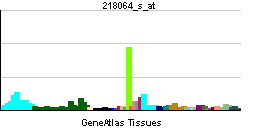AKAP8L
| A kinase (PRKA) anchor protein 8-like | |||||||||||
|---|---|---|---|---|---|---|---|---|---|---|---|
| Identifiers | |||||||||||
| Symbols | AKAP8L ; DKFZp434L0650; HAP95; NAKAP; NAKAP95 | ||||||||||
| External IDs | Template:OMIM5 Template:MGI HomoloGene: 8658 | ||||||||||
| |||||||||||
| RNA expression pattern | |||||||||||
 | |||||||||||
| More reference expression data | |||||||||||
| Orthologs | |||||||||||
| Template:GNF Ortholog box | |||||||||||
| Species | Human | Mouse | |||||||||
| Entrez | n/a | n/a | |||||||||
| Ensembl | n/a | n/a | |||||||||
| UniProt | n/a | n/a | |||||||||
| RefSeq (mRNA) | n/a | n/a | |||||||||
| RefSeq (protein) | n/a | n/a | |||||||||
| Location (UCSC) | n/a | n/a | |||||||||
| PubMed search | n/a | n/a | |||||||||
A kinase (PRKA) anchor protein 8-like, also known as AKAP8L, is a human gene.[1]
References
Further reading
- Maruyama K, Sugano S (1994). "Oligo-capping: a simple method to replace the cap structure of eukaryotic mRNAs with oligoribonucleotides". Gene. 138 (1–2): 171–4. PMID 8125298.
- Bonaldo MF, Lennon G, Soares MB (1997). "Normalization and subtraction: two approaches to facilitate gene discovery". Genome Res. 6 (9): 791–806. PMID 8889548.
- Suzuki Y, Yoshitomo-Nakagawa K, Maruyama K; et al. (1997). "Construction and characterization of a full length-enriched and a 5'-end-enriched cDNA library". Gene. 200 (1–2): 149–56. PMID 9373149.
- Ueki N, Oda T, Kondo M; et al. (1999). "Selection system for genes encoding nuclear-targeted proteins". Nat. Biotechnol. 16 (13): 1338–42. doi:10.1038/4315. PMID 9853615.
- Seki N, Ueki N, Yano K; et al. (2000). "cDNA cloning of a novel human gene NAKAP95, neighbor of A-kinase anchoring protein 95 (AKAP95) on chromosome 19p13.11-p13.12 region". J. Hum. Genet. 45 (1): 31–7. PMID 10697960.
- Westberg C, Yang JP, Tang H; et al. (2000). "A novel shuttle protein binds to RNA helicase A and activates the retroviral constitutive transport element". J. Biol. Chem. 275 (28): 21396–401. doi:10.1074/jbc.M909887199. PMID 10748171.
- Orstavik S, Eide T, Collas P; et al. (2000). "Identification, cloning and characterization of a novel nuclear protein, HA95, homologous to A-kinase anchoring protein 95". Biol. Cell. 92 (1): 27–37. PMID 10761695.
- Martins SB, Eide T, Steen RL; et al. (2001). "HA95 is a protein of the chromatin and nuclear matrix regulating nuclear envelope dynamics". J. Cell. Sci. 113 Pt 21: 3703–13. PMID 11034899.
- Yang JP, Tang H, Reddy TR, Wong-Staal F (2001). "Mapping the functional domains of HAP95, a protein that binds RNA helicase A and activates the constitutive transport element of type D retroviruses". J. Biol. Chem. 276 (33): 30694–700. doi:10.1074/jbc.M102809200. PMID 11402034.
- Wistow G, Bernstein SL, Ray S; et al. (2002). "Expressed sequence tag analysis of adult human iris for the NEIBank Project: steroid-response factors and similarities with retinal pigment epithelium". Mol. Vis. 8: 185–95. PMID 12107412.
- Strausberg RL, Feingold EA, Grouse LH; et al. (2003). "Generation and initial analysis of more than 15,000 full-length human and mouse cDNA sequences". Proc. Natl. Acad. Sci. U.S.A. 99 (26): 16899–903. doi:10.1073/pnas.242603899. PMID 12477932.
- Martins S, Eikvar S, Furukawa K, Collas P (2003). "HA95 and LAP2 beta mediate a novel chromatin-nuclear envelope interaction implicated in initiation of DNA replication". J. Cell Biol. 160 (2): 177–88. doi:10.1083/jcb.200210026. PMID 12538639.
- Martins SB, Marstad A, Collas P (2003). "In vitro modulation of the interaction between HA95 and LAP2beta by cAMP signaling". Biochemistry. 42 (35): 10456–61. doi:10.1021/bi0350699. PMID 12950172.
- Ota T, Suzuki Y, Nishikawa T; et al. (2004). "Complete sequencing and characterization of 21,243 full-length human cDNAs". Nat. Genet. 36 (1): 40–5. doi:10.1038/ng1285. PMID 14702039.
- Bouwmeester T, Bauch A, Ruffner H; et al. (2004). "A physical and functional map of the human TNF-alpha/NF-kappa B signal transduction pathway". Nat. Cell Biol. 6 (2): 97–105. doi:10.1038/ncb1086. PMID 14743216.
- Beausoleil SA, Jedrychowski M, Schwartz D; et al. (2004). "Large-scale characterization of HeLa cell nuclear phosphoproteins". Proc. Natl. Acad. Sci. U.S.A. 101 (33): 12130–5. doi:10.1073/pnas.0404720101. PMID 15302935.
- Gerhard DS, Wagner L, Feingold EA; et al. (2004). "The status, quality, and expansion of the NIH full-length cDNA project: the Mammalian Gene Collection (MGC)". Genome Res. 14 (10B): 2121–7. doi:10.1101/gr.2596504. PMID 15489334.
- Rual JF, Venkatesan K, Hao T; et al. (2005). "Towards a proteome-scale map of the human protein-protein interaction network". Nature. 437 (7062): 1173–8. doi:10.1038/nature04209. PMID 16189514.
- Sayer JA, Manczak M, Akileswaran L; et al. (2006). "Interaction of the nuclear matrix protein NAKAP with HypA and huntingtin: implications for nuclear toxicity in Huntington's disease pathogenesis". Neuromolecular Med. 7 (4): 297–310. PMID 16391387.
- Ewing RM, Chu P, Elisma F; et al. (2007). "Large-scale mapping of human protein-protein interactions by mass spectrometry". Mol. Syst. Biol. 3: 89. doi:10.1038/msb4100134. PMID 17353931.
| This protein-related article is a stub. You can help Wikipedia by expanding it. |